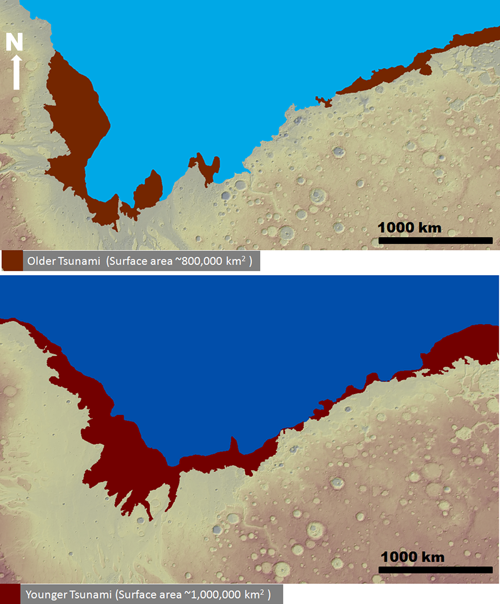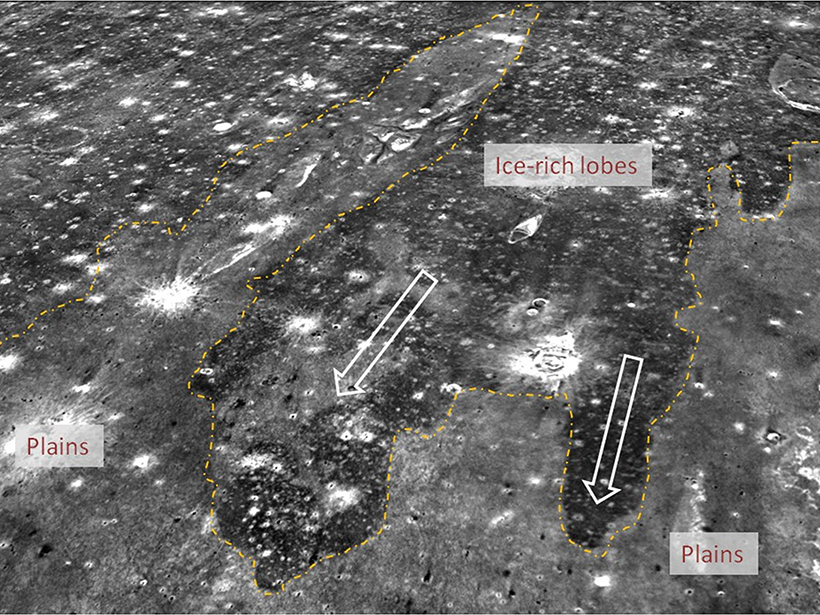The northern hemisphere of Mars hosts a vast, smooth basin that looks as though it could have once held an ocean. However, the basin lacks topographic features of an obvious and complete ancient shoreline, and so planetary scientists have debated this tantalizing possibility for decades.
Now a team of researchers has given extraordinary new scrutiny to the landforms of this Martian region. As a result, the scientists have identified huge deposits of rocks and sediments, backwash gullies, and other topographic features on the edges of the basin. They report that these features were likely produced when tsunamis raced through the basin’s ocean roughly 3.4 billion years ago.
Signs of a Martian ocean sustained for millions of years between meteorite impacts bolster the possibility that the Red Planet offered a tolerable environment for life.
The evidence suggests that two separate tsunamis stormed through the ocean—which encircled the north pole and could have been one third the size of the entire globe—some millions of years apart. The new signs of a Martian ocean sustained for millions of years between meteorite impacts bolster the possibility that the Red Planet offered a tolerable environment for life at the time, the researchers said.
“It is difficult to imagine summer Californian beaches on early Mars, but try picturing Norwegian iced fjords during a particularly cold winter and maybe you’ll get a more accurate picture,” said Alberto Fairén of the Center of Astrobiology in Madrid, Spain, who participated in the research and is a visiting scientist at Cornell University in Ithaca, N.Y.
He, first author Alexis Rodriguez of the Planetary Science Institute in Tucson, Ariz., and their colleagues published the analysis today in Nature Scientific Reports.
Mighty Waves Resculpted Ocean Shore
The team used three data sets—visible images, altimeter data, and thermal images—from the Mars Reconnaissance Orbiter and the Mars Global Surveyor to probe a small section of the northern plains. The images show two different populations of semicircular sedimentary deposits called lobes, one of which is associated with backwash channels and massive boulders aligned within those channels.
From the features, Rodriguez and his colleagues have been able to piece together a detailed story of what transpired to create those landforms long ago.
The first tsunami swept past the shoreline, the team contends, entraining with it boulders as wide as 10 meters, until it hit surrounding highlands. There the water rolled uphill and left sediments behind until it retreated into the ocean. As the waters washed inward, they gouged enormous backwash channels along the shore and aligned boulders within those channels.
Big Chill
During the thousands of millennia between that tsunami and the next, Mars underwent serious global cooling, the team asserts, during which the ocean partially froze and much of it evaporated, causing its sea level to drop by about 300 meters and the shorelines to retreat.
When the second projectile eventually smacked into the smaller, ice-rich ocean, a second tsunami washed ashore. Unlike the previous event, this tsunami didn’t realign boulders or even leave backwash channels. “You can imagine that if you have water and you spill it over a frozen surface, it will freeze over very fast because it’s thin,” said Rodriguez. “So the tsunami basically freezes in situ and it doesn’t enter a backwash phase. It just stays there.”
In their paper, the researchers compare the icy, more recent tsunami to an event that was recorded in 2013 in the Codette Reservoir in Saskatchewan, Canada. “The ice surge triggered catastrophic ice-rich floes and led to the emplacement of enormous lobate fronts, which are very similar to those shown in our area of study on Mars,” said Fairén.

Out of This World Tsunamis
Despite the cooler conditions at the time of the second impact and tsunami, both inundations went way off the charts compared with typical tsunamis on Earth. The waters surged as far as 650 kilometers inland and submerged as many as a million square kilometers of land. “These run-up distances and inundation areas are enormous by terrestrial standards,” the team noted in its paper.
The researchers chalk up the tsunamis to strikes by meteorites big enough to have left behind craters roughly 30 kilometers in diameter—a scale of impact that took place with about the right frequency back then to support this Martian tsunami hypothesis, the team reported.
Implications for Extraterrestrial Life
To Greg Michael of the Free University of Berlin in Germany, who was not involved in the research, the evidence for a lingering ocean on early Mars suggests exciting implications. “This obviously is very interesting if you want to talk about the possibility of life,” he said.
If the ocean once contained life, organisms might remain encased within the icy lobes piled up by the more recent tsunami, Rodriguez said. Even if those lobes lack frozen microbes, they might tell scientists whether the chemistry of the ancient ocean was at least conducive to life.
What’s more, said coauthor and retired scientist Kenneth Tanaka of the U.S. Geological Survey in Flagstaff, Ariz., the Curiosity mission’s presence in Gale crater just a couple of hundred kilometers away from the lobes has already demonstrated the feasibility of a future rover reaching the tsunami site. The new analysis “will definitely move the compass toward [the icy lobes],” he added, “but whether the exploration committees would point NASA to go toward these, it’s hard to say.”
—Shannon Hall, Freelance Writer; email: [email protected]
Citation:
Hall, S. (2016), Tsunamis splashed ancient Mars, Eos, 97, https://doi.org/10.1029/2016EO052681. Published on 19 May 2016.
Text © 2016. The authors. CC BY-NC-ND 3.0
Except where otherwise noted, images are subject to copyright. Any reuse without express permission from the copyright owner is prohibited.

